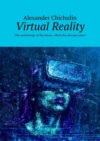Kitabı oku: «Virtual Reality. This technology of the future, which has already come!», sayfa 2
Chapter 1: Understanding Virtual Reality Technology
Virtual reality (VR) technology is a form of immersive media that allows users to experience a computer-generated environment as if they were actually there. This is achieved by using a combination of hardware and software to simulate real-life sensory experiences, such as sight, sound, and touch.
At its core, VR technology relies on a few key components. The first is the display, which can take the form of a head-mounted display (HMD) or a large projection screen. The display is typically connected to a computer or gaming console that runs the VR software.
The second key component is motion tracking technology, which allows the user’s movements to be translated into the virtual environment. This is often achieved through the use of sensors or cameras that track the user’s movements in real-time.
The third component is haptic feedback technology, which allows users to feel physical sensations within the virtual environment. This can take the form of vibrations, pressure, or temperature changes.
Together, these components work to create a fully immersive experience for the user, allowing them to feel as if they are truly present within the virtual environment.
One of the key benefits of VR technology is its ability to provide a more engaging and interactive experience than traditional media. With VR, users can interact with the environment in a way that mimics real-life experiences, making it a popular tool for education, training, and gaming. For example, VR can be used to simulate real-world scenarios, such as medical procedures or construction projects, allowing users to practice in a safe and controlled environment.
However, VR technology is not without its limitations. One of the biggest challenges is the issue of motion sickness, which can occur when the user’s movements within the virtual environment do not match up with their physical movements in the real world. This can lead to feelings of nausea, dizziness, and disorientation.
Despite these challenges, VR technology has already made significant strides in gaming and entertainment, and its potential applications in a wide range of industries are only just beginning to be explored. As the technology continues to evolve and become more accessible, we can expect to see even more innovative and exciting uses of VR in the future.
– Types of virtual reality technology
Virtual reality technology is constantly evolving and there are now several different types of VR technology available. Each type offers its own unique features and benefits, making it important to understand the differences between them.
1. Desktop Virtual Reality: Desktop VR refers to VR experiences that are run on a computer or gaming console, and are typically viewed through a monitor or TV screen. These types of experiences often require a controller or keyboard to interact with the virtual environment.
2. Mobile Virtual Reality: Mobile VR technology is designed to work with smartphones and other mobile devices. These types of VR experiences are typically viewed through a headset that holds the mobile device in place. Mobile VR offers a more affordable and portable option than desktop VR, but can be limited by the processing power of the mobile device.
3. Augmented Reality: Augmented reality (AR) technology combines virtual and real-world environments, overlaying digital objects onto the real world. AR is typically experienced through a mobile device or headset, and allows users to interact with digital objects in a real-world setting.
4. Mixed Reality: Mixed reality (MR) technology is similar to AR, but takes the experience one step further by allowing digital objects to interact with the real world in a more realistic way. MR technology typically uses a headset or glasses to overlay digital objects onto the real world, and allows users to interact with them using natural movements.
5. Immersive Virtual Reality: Immersive VR technology is designed to provide a fully immersive experience, with users completely surrounded by the virtual environment. This is typically achieved through the use of a head-mounted display (HMD), motion tracking, and haptic feedback technology.
Each type of VR technology has its own advantages and disadvantages, and the choice of which to use will depend on the intended use and specific requirements of the VR experience. While desktop and mobile VR are more affordable and accessible, they can be limited by the processing power of the computer or mobile device. Augmented and mixed reality technology can be more versatile, but may not provide the same level of immersion as immersive VR. As VR technology continues to evolve, we can expect to see new types of VR experiences and technology emerging in the future.
– Components of virtual reality systems
Virtual reality (VR) technology is a complex system that requires several components to work together in order to provide a fully immersive experience for the user. These components can be broken down into three main categories: hardware, software, and user interface.
Hardware:
The hardware components of a VR system are responsible for creating and displaying the virtual environment. This includes:
1. Head-Mounted Display (HMD): The HMD is a wearable device that displays the virtual environment to the user. It typically includes two screens, one for each eye, and is connected to the computer or console that runs the VR software.
2. Motion Tracking Sensors: Motion tracking sensors are used to track the user’s movements and translate them into the virtual environment. This can be done using cameras, infrared sensors, or other specialized hardware.
3. Controllers: Controllers are used to interact with the virtual environment and can take many forms, including handheld controllers, gloves, or specialized equipment for specific applications.
Software:
The software components of a VR system are responsible for creating and rendering the virtual environment. This includes:
1. Game Engine: The game engine is the software that creates and runs the virtual environment. It includes tools for creating 3D models, physics simulations, and other elements of the VR experience.
2. Rendering Software: The rendering software is responsible for creating the images and visual effects that make up the virtual environment. This includes lighting, textures, and other visual elements.
User Interface:
The user interface components of a VR system are responsible for allowing the user to interact with the virtual environment. This includes:
1. Menus and Controls: Menus and controls are used to navigate the virtual environment and interact with virtual objects.
2. Audio: Audio is an important component of the VR experience, providing spatial audio cues that help to immerse the user in the virtual environment.
3. Haptic Feedback: Haptic feedback technology provides physical feedback to the user, allowing them to feel physical sensations within the virtual environment. This can include vibrations, pressure, or temperature changes.
In order for a VR system to work effectively, all of these components must work together seamlessly. Advances in VR technology are constantly improving the capabilities of these components, leading to more immersive and engaging VR experiences for users.
– Advantages and limitations of virtual reality technology
Chapter 3: Advantages and Limitations of Virtual Reality Technology
Virtual reality (VR) technology has many potential advantages for a wide range of applications, from entertainment and gaming to healthcare and education. However, it also has some limitations that must be considered when using or developing VR systems.
Advantages of Virtual Reality Technology:
1. Immersive Experience: VR technology can provide a highly immersive experience that can transport users to different environments or situations. This can be especially beneficial for training, education, or entertainment purposes.
2. Enhanced Learning and Retention: Studies have shown that VR can be an effective tool for learning and retention, as it can provide hands-on experience in a simulated environment that closely mirrors real-world situations.
3. Safety and Risk Reduction: VR can be used to simulate dangerous or high-risk scenarios, allowing individuals to practice and learn without the risk of harm. This can be especially useful in fields like healthcare, emergency response, or military training.
4. Cost-Effective: VR can be a cost-effective alternative to physical training or testing, as it eliminates the need for expensive equipment, travel, or specialized facilities.
5. Accessibility: VR can be used to provide access to experiences that may be difficult or impossible to access in real life, such as historical sites, remote locations, or even outer space.
Limitations of Virtual Reality Technology:
1. Technical Limitations: VR technology is still in its early stages, and there are technical limitations to what is currently possible. This includes limitations in resolution, graphics quality, and processing power.
2. Physical Discomfort: Some users may experience physical discomfort while using VR, including motion sickness, eye strain, or fatigue. This can be a limiting factor for some applications, especially for extended periods of use.
3. Limited Social Interaction: VR can be an isolating experience, as users are often immersed in a virtual environment without physical interaction with others. This can be a limitation for applications that require social interaction or collaboration.
4. Development and Maintenance Costs: Developing and maintaining VR systems can be expensive, as it requires specialized hardware and software development, as well as ongoing maintenance and updates.
5. Ethical Concerns: As with any emerging technology, there are ethical concerns surrounding the use of VR, including privacy, safety, and potential for addiction.
Despite these limitations, VR technology continues to evolve and expand, with new applications and uses being discovered all the time. As the technology advances and becomes more accessible, it is likely that the advantages of VR will continue to outweigh the limitations, leading to more widespread adoption and use in a variety of fields.
Ücretsiz ön izlemeyi tamamladınız.




















